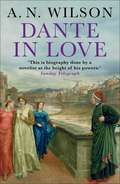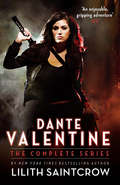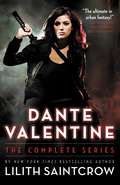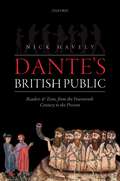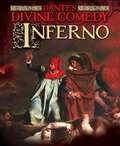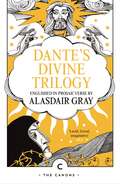- Table View
- List View
Dante in Love: A Biography
by A. N. WilsonWith a biographer's eye for detail and a novelist's comprehension of the creative process, A. N. Wilson paints a masterful portrait of Dante Alighieri and unlocks one of the seminal works of literature for a new generation of readers.In Dante in Love, A. N. Wilson presents a glittering study of an artist and his world, arguing that without an understanding of medieval Florence, it is impossible to comprehend the meaning of Dante's great poem. He explains how the Italian States were at that time locked into violent feuds, mirrored in the ferocious competition between the Holy Roman Empire and the papacy. He explores Dante's preoccupations with classical mythology, numerology and the great Christian philosophers which inform every line of the Comedy. Dante in Love also lays bare the enigma of the man who never wrote about the mother of his children, yet immortalized the mysterious Beatrice, whom he barely knew.
Dante, Michelangelo and Milton (Routledge Revivals)
by John ArthosOriginally published in 1963, this is a study of the greatness of Dante, Michelangelo and Milton, and of the differences in the power and effect of their work. This book shows how differing philosophical commitments help explain differences in the character of their greatness. The ancient treatise On the Sublime provides the starting point for these studies and in an introductory essay the author examines Longinus’ obligations to Platonic and Stoic philosophy. In the essays which relate the critical doctrines of Dante, Michelangelo and Milton to philosophy, he shows how far their thought accords with Longinus’ and to what degree they depend upon the same philosophic traditions. The final emphasis, however, is upon the relation of their ideas to the distinctive elements of their greatness.
Dante, Michelangelo and Milton (Routledge Revivals)
by John ArthosOriginally published in 1963, this is a study of the greatness of Dante, Michelangelo and Milton, and of the differences in the power and effect of their work. This book shows how differing philosophical commitments help explain differences in the character of their greatness. The ancient treatise On the Sublime provides the starting point for these studies and in an introductory essay the author examines Longinus’ obligations to Platonic and Stoic philosophy. In the essays which relate the critical doctrines of Dante, Michelangelo and Milton to philosophy, he shows how far their thought accords with Longinus’ and to what degree they depend upon the same philosophic traditions. The final emphasis, however, is upon the relation of their ideas to the distinctive elements of their greatness.
Dante on View: The Reception of Dante in the Visual and Performing Arts
by ANTONELLA BRAIDA AND LUISA CALÈDante on View opens an important new dimension in Dante studies: for the first time a collection of essays analyses the presence of the Italian Medieval poet Dante Alighieri in the visual and performing arts from the Middle Ages to the present day. The essays in this volume explore the image of Dante emerging in medieval illuminated manuscripts and later ideological and nostalgic uses of the poet. The volume also demonstrates the rich diversity of projects inspired by the Commedia both as an overall polysemic structure and as a repository of scenes, which generate a repertoire for painters, actors and film-makers. In its original multimediality, Dante's Commedia stimulates the performance of readers and artists working in different media from manuscript to stage, from ballet to hyperinstruments, from film to television. Through such a variety of media, the reception of Dante in the visual and performing arts enriches our understanding of the poet and of the arts represented at key moments of formal and structural change in the European cultural world.
Dante on View: The Reception of Dante in the Visual and Performing Arts
by Antonella Braida Luisa CalèDante on View opens an important new dimension in Dante studies: for the first time a collection of essays analyses the presence of the Italian Medieval poet Dante Alighieri in the visual and performing arts from the Middle Ages to the present day. The essays in this volume explore the image of Dante emerging in medieval illuminated manuscripts and later ideological and nostalgic uses of the poet. The volume also demonstrates the rich diversity of projects inspired by the Commedia both as an overall polysemic structure and as a repository of scenes, which generate a repertoire for painters, actors and film-makers. In its original multimediality, Dante's Commedia stimulates the performance of readers and artists working in different media from manuscript to stage, from ballet to hyperinstruments, from film to television. Through such a variety of media, the reception of Dante in the visual and performing arts enriches our understanding of the poet and of the arts represented at key moments of formal and structural change in the European cultural world.
Dante the Lyric and Ethical Poet: Dante Lirico E Etico
by Zygmunt G. Bara'nski"This book presents the proceedings of the fifth meeting of the International Dante Seminar. As with previous volumes, the proceedings also include a carefully edited account of the extensive discussions which followed the presentations. The papers, given by some of the leading international scholars of the poet - from Italy, the UK and the USA - address four major topics of particular concern to present-day Dante studies: Dante as a lyric poet; Dante as an ethical poet; Dante and the Eclogues; and Dante in nineteenth-century Britain. These topics reflect both areas which are currently the subject of heated critical debate (several editions of the lyric poems are in preparation, and the ethical dimension of Dantes works is very much under discussion) and areas which are long overdue a reassessment (Dantes remarkable revival of Latin pastoral poetry, and the extraordinary British contribution to Dante studies in the nineteenth century). As this set of conference proceedings makes clear, in Dante and in his legacy, ethics and poetry are inseparable. The contributors include Paola Allegretti, Michael Caesar, Paolo Falzone, Manuele Gragnolati, Claudio Giunta, Claire Honess, Robin Kirkpatrick, John Lindon, Lino Pertile, Justin Steinberg, Claudia Villa, and Diego Zancani."
Dante the Lyric and Ethical Poet: Dante Lirico E Etico
by Zygmunt G. Bara'nski"This book presents the proceedings of the fifth meeting of the International Dante Seminar. As with previous volumes, the proceedings also include a carefully edited account of the extensive discussions which followed the presentations. The papers, given by some of the leading international scholars of the poet - from Italy, the UK and the USA - address four major topics of particular concern to present-day Dante studies: Dante as a lyric poet; Dante as an ethical poet; Dante and the Eclogues; and Dante in nineteenth-century Britain. These topics reflect both areas which are currently the subject of heated critical debate (several editions of the lyric poems are in preparation, and the ethical dimension of Dantes works is very much under discussion) and areas which are long overdue a reassessment (Dantes remarkable revival of Latin pastoral poetry, and the extraordinary British contribution to Dante studies in the nineteenth century). As this set of conference proceedings makes clear, in Dante and in his legacy, ethics and poetry are inseparable. The contributors include Paola Allegretti, Michael Caesar, Paolo Falzone, Manuele Gragnolati, Claudio Giunta, Claire Honess, Robin Kirkpatrick, John Lindon, Lino Pertile, Justin Steinberg, Claudia Villa, and Diego Zancani."
Dante Valentine: The Complete Series (Dante Valentine Novels #2)
by Lilith SaintcrowNecromancer. Bounty hunter. Killer.Dante Valentine has been all three in her life. But in the beginning, she was a Necromancer for hire. And while she was choosy about her jobs, there were just some she couldn't turn down - like when the Devil showed up at the door and offered her a deal. Her life - in exchange for the capture and elimination of a renegade demon. But how do you kill something that can't die?This omnibus edition contains these titles: Workng for the Devil, Dead Man Rising, The Devil's Right Hand, Saint City Sinners and To Hell and Back.
Dante Valentine: The Complete Series (Dante Valentine)
by Lilith SaintcrowNecromancer. Bounty hunter. Killer.Dante Valentine has been all three in her life. But in the beginning, she was a Necromancer for hire. And while she was choosy about her jobs, there were just some she couldn't turn down. Like when the Devil showed up at the door and offered her a deal. Her life - in exchange for the capture and elimination of a renegade demon. But how do you kill something that can't die?Dante Valentine, one of urban fantasy's hottest series, is compiled into one volume for the first time. Included in this omnibus edition are: Working for the Devil, Dead Man Rising, The Devil's Right Hand, Saint City Sinners, and To Hell and Back. Dante Valentine NovelsWorking for the DevilDead Man RisingDevil's Right HandSaint City SinnersTo Hell and BackDante Valentine (omnibus)For more from Lilith Saintcrow, check out: Gallow and RaggedTrailer Park FaeBannon and ClareThe Iron Wyrm AffairThe Red Plague AffairThe Ripper AffairThe Damnation Affair (e-only)Jill Kismet NovelsNight ShiftHunter's PrayerRedemption AlleyFlesh CircusHeaven's SpiteAngel TownJill Kismet (omnibus)A Romance of Arquitaine NovelsThe Hedgewitch QueenThe Bandit KingBlood Call (coming August 2015)
Dante: A Very Short Introduction (Very Short Introductions)
by Peter Hainsworth David RobeyIn this Very Short Introduction, Peter Hainsworth and David Robey take a different approach to Dante, by examining the main themes and issues that run through all of his work, ranging from autobiography, to understanding God and the order of the universe. In doing so, they highlight what has made Dante a vital point of reference for modern writers and readers, both inside and outside Italy. They emphasize the distinctive and dynamic interplay in Dante's writing between argument, ideas, and analysis on the one hand, and poetic imagination on the other. Dante was highly concerned with the political and intellectual issues of his time, demonstrated most powerfully in his notorious work, The Divine Comedy. Tracing the tension between the medieval and modern aspects, Hainsworth and Robey provide a clear insight into the meaning of this masterpiece of world literature. They highlight key figures and episodes in the poem, bringing out the originality and power of Dante's writing to help readers understand the problems that Dante wanted his audience to confront but often left up to the reader to resolve. ABOUT THE SERIES: The Very Short Introductions series from Oxford University Press contains hundreds of titles in almost every subject area. These pocket-sized books are the perfect way to get ahead in a new subject quickly. Our expert authors combine facts, analysis, perspective, new ideas, and enthusiasm to make interesting and challenging topics highly readable.
Dante: A Very Short Introduction (Very Short Introductions)
by Peter Hainsworth David RobeyIn this Very Short Introduction, Peter Hainsworth and David Robey take a different approach to Dante, by examining the main themes and issues that run through all of his work, ranging from autobiography, to understanding God and the order of the universe. In doing so, they highlight what has made Dante a vital point of reference for modern writers and readers, both inside and outside Italy. They emphasize the distinctive and dynamic interplay in Dante's writing between argument, ideas, and analysis on the one hand, and poetic imagination on the other. Dante was highly concerned with the political and intellectual issues of his time, demonstrated most powerfully in his notorious work, The Divine Comedy. Tracing the tension between the medieval and modern aspects, Hainsworth and Robey provide a clear insight into the meaning of this masterpiece of world literature. They highlight key figures and episodes in the poem, bringing out the originality and power of Dante's writing to help readers understand the problems that Dante wanted his audience to confront but often left up to the reader to resolve. ABOUT THE SERIES: The Very Short Introductions series from Oxford University Press contains hundreds of titles in almost every subject area. These pocket-sized books are the perfect way to get ahead in a new subject quickly. Our expert authors combine facts, analysis, perspective, new ideas, and enthusiasm to make interesting and challenging topics highly readable.
Dante's British Public: Readers and Texts, from the Fourteenth Century to the Present
by Nick HavelyThis is the first account of Dante's reception in English to address full chronological span of that process. Individual authors and periods have been studied before, but Dante's British Public takes a wider and longer view, using a selection of vivid and detailed case studies to record and place in context some of the wider conversations about and appropriations of Dante that developed in Britain across more than six centuries, as access to his work extended and diversified. Much of the evidence is based on previously unpublished material in (for example) letters, journals, annotations and inventories and is drawn from archives in the UK and across the world, from Milan to Mumbai and from Berlin to Cape Town. Throughout, the role of Anglo-Italian cultural contacts and intermediaries in shaping the public understanding of Dante in Britain is given prominence - from clerics and merchants around Chaucer's time, through itinerant scholars, collectors and tourists in the early modern period, to the exiles and expatriates of the nineteenth and twentieth centuries. The final chapter brings the story up to the present, showing how the poet's work has been seen (from the fourteenth century onwards) as accessible to 'the many', and demonstrating some of the means by which Dante has reached a yet wider British public over the past century, particularly through translation, illustration, and various forms of performance.
Dante's Commedia: Elements of Structure
by Charles S. SingletonThis book contains four essays by Professor Charles Singleton: "Allegory," "Symbolism," "The Pattern at the Center," and "The Substance of Things Seen." These four essays treat four dimensions of meaning essential to understanding the substance and special texture of the poetry of the Divine Comedy. One might speak of "facets" or "aspects" of meaning if such terms did not suggest surface reflections dependent on the way a work (as a jewel) is turned for inspection. But for Singleton, each dimension has a depth that reaches to the core and substance of Dante's poetry, so they are, in Singleton's view, elements of its structure.
Dante's Commedia: Elements of Structure
by Charles S. SingletonThis book contains four essays by Professor Charles Singleton: "Allegory," "Symbolism," "The Pattern at the Center," and "The Substance of Things Seen." These four essays treat four dimensions of meaning essential to understanding the substance and special texture of the poetry of the Divine Comedy. One might speak of "facets" or "aspects" of meaning if such terms did not suggest surface reflections dependent on the way a work (as a jewel) is turned for inspection. But for Singleton, each dimension has a depth that reaches to the core and substance of Dante's poetry, so they are, in Singleton's view, elements of its structure.
Dante's Divine Comedy
by Seymour ChwastThe "left-handed designer," Seymour Chwast has been putting his unparalleled take-and influence-on the world of illustration and design for the last half century. In his version of Dante's Divine Comedy, Chwast's first graphic novel, Dante and his guide Virgil don fedoras and wander through noir-ish realms of Hell, Purgatory, and Paradise, finding both the wicked and the wondrous on their way. Dante Alighieri wrote his epic poem The Divine Comedy from 1308 to 1321 while in exile from his native Florence. In the work's three parts (Inferno, Purgatory, and Paradise), Dante chronicles his travels throughthe afterlife, cataloging a multitude of sinners and saints-many of them real people to whom Dante tellingly assigned either horrible punishment or indescribable pleasure-and eventually meeting both God and Lucifer face-to-face. In his adaptation of this skewering satire, Chwast creates a visual fantasia that fascinates on every page: From the multifarious torments of the Inferno to the host of delights in Paradise, his inventive illustrations capture the delirious complexity of this classic of the Western canon.
Dante's Divine Comedy (The Landmark Library #12)
by Ian ThomsonA TLS Book of the Year. 'Erudite and urgent, Ian Thomson's Dante's Divine Comedy is another book that everyone ought to read' Spectator. 'Succinct but wide-ranging, Ian Thomson's richly illustrated exploration of Dante's masterpiece is... fun... ingenious... fascinating' Observer. 'A book worth savouring as a chunky, chatty, richly illustrated guide that brings Dante and his world within our reach' Evening Standard. A lively and wide-ranging exploration of a literary masterwork and its influence on writers, poets, artists and film-makers up to our own time. Dante has no equal as he sings of other-worldly horror and celestial beatitude alike. Yet for all our distance from medieval theology, the Florentine poet's allegorical journey through hell, purgatory and paradise remains one of the essential works of world literature. At least fifty English language versions of the Inferno – the first part of Dante's poem – appeared in the twentieth century alone. If Dante's Divine Comedy speaks to our present condition, it is because it tells the story of Everyman who sets out in search of salvation in this world. Dante composed his great poem in the spoken Italian of his time. He wrote about suffering bodies and human weakness, and about divine ecstasy, in words that have resonated with readers and writers for the last seven hundred years.
Dante’s Divine Comedy in Early Renaissance England: The Collision of Two Worlds
by Jonathan HughesDante's Divine Comedy in Early Renaissance England compares the intellectual, emotional, and religious world of Dante in 13th-century Florence with that of a group of English intellectuals gathered around Humphrey, Duke of Gloucester, uncle of the King, Henry VI. Here, Jonathan Hughes establishes that there was a Renaissance in 15th-century England, encouraged by the discovery and translations of works of Greek philosophers and developments in science and medicine; and that vernacular writers in Gloucester's circle, such as John Lydgate and Robert Hoccleve, were of fundamental importance in exploring the meaning of the self and man's relationship with the natural world and the classical past. However, the appearance in 15th-century England of Dante's 'Commedia', the most popular work of the Middle Ages, served to remind writers and readers of the cost of intellectual enquiry: the loss of faith in a harmonious and beautiful world; the redemptive power of the love of a woman; and the tangible presence of an afterlife.Engagingly written and meticulously researched, this innovative study shines a new perspective on Dante scholarship as well as offering a unique anaylsis of intellectual thought and culture in 15th-century England.
Dante’s Divine Comedy in Early Renaissance England: The Collision of Two Worlds
by Jonathan HughesDante's Divine Comedy in Early Renaissance England compares the intellectual, emotional, and religious world of Dante in 13th-century Florence with that of a group of English intellectuals gathered around Humphrey, Duke of Gloucester, uncle of the King, Henry VI. Here, Jonathan Hughes establishes that there was a Renaissance in 15th-century England, encouraged by the discovery and translations of works of Greek philosophers and developments in science and medicine; and that vernacular writers in Gloucester's circle, such as John Lydgate and Robert Hoccleve, were of fundamental importance in exploring the meaning of the self and man's relationship with the natural world and the classical past. However, the appearance in 15th-century England of Dante's 'Commedia', the most popular work of the Middle Ages, served to remind writers and readers of the cost of intellectual enquiry: the loss of faith in a harmonious and beautiful world; the redemptive power of the love of a woman; and the tangible presence of an afterlife.Engagingly written and meticulously researched, this innovative study shines a new perspective on Dante scholarship as well as offering a unique anaylsis of intellectual thought and culture in 15th-century England.
Dante's Divine Comedy: Inferno
by Dante AlighieriThe Inferno is by far the most popular and well-known of the books in the Divine Comedy trilogy because of its depiction and understanding of the moral and spiritual pitfalls which still plague us today. This edition is illustrated with astonishing artworks, from Hieronymus Bosch's depictions of a surreal, hellish landscapes and other Renaissance visions of the Last Judgement, to Gustave Doré's intricate engravings of the pilgrim's spiritual travails.
Dante's Divine Trilogy: Dante's Divine Trilogy Part Three. Englished In Prosaic Verse By Alasdair Gray (Canons)
by Dante Alighieri Alasdair GrayIn this masterful retelling of one of the greatest works of world literature, Alasdair Gray - in his last work - offers an original translation in prosaic English rhyme. Lyrical and modern, this complete edition brings all three parts of Dante's epic journey through Hell and Purgatory and on to Paradise together in a single volume for the first time.
Dante's Drama of the Mind: A Modern Reading of the Purgatorio (PDF)
by Francis FergussonThe individual insights employed in this reading of the Purgatorio are those of a twentieth-century mind, as are the author's references: T. S. Eliot, Henry James, I.A. Richards, Jacques Maritain, and many others. Purposely avoiding the pitfalls of Dantean scholarship, Mr. Fergusson reveals the drama of the order of Dante’s vision, the developed form of the poetry, and the meaning of the canticle for modern man. "The Purgatorio," he says, “has light to shed upon history and its making; upon psychology, ethics, and education; upon politics and the transmission of our tradition. There are many reasons for learning to read it; it is a central clue.” This brilliantly written book by the author of The Idea of a Theater is itself a central clue to the meaning of the Purgatorio.Originally published in 1953.The Princeton Legacy Library uses the latest print-on-demand technology to again make available previously out-of-print books from the distinguished backlist of Princeton University Press. These editions preserve the original texts of these important books while presenting them in durable paperback and hardcover editions. The goal of the Princeton Legacy Library is to vastly increase access to the rich scholarly heritage found in the thousands of books published by Princeton University Press since its founding in 1905.
Dante's Education: Latin Schoolbooks and Vernacular Poetics (Oxford Studies in Medieval Literature and Culture)
by Filippo GianferrariIn fourteenth-century Italy, literacy became accessible to a significantly larger portion of the lay population (allegedly between 60 and 80 percent in Florence) and provided a crucial means for the vernacularization and secularization of learning, and for the democratization of citizenship. Dante Alighieri's education and oeuvre sit squarely at the heart of this historical and cultural transition and provide an ideal case study for investigating the impact of Latin education on the consolidation of autonomous vernacular literature in the Middle Ages, a fascinating and still largely unexamined phenomenon. On the basis of manuscript and archival evidence, Gianferrari reconstructs the contents, practice, and readings of Latin instruction in the urban schools of fourteenth-century Florence. It also shows Dante's continuous engagement with this culture of teaching in his poetics, thus revealing his contribution to the expansion of vernacular literacy and education. The book argues that to achieve his unprecedented position of authority as a vernacular intellectual, Dante conceived his poetic works as an alternative educational program for laypeople, who could read and write in the vernacular but had little or no proficiency in Latin. By reconstructing the culture of literacy shared by Dante and his lay readers, Dante's Education shifts critical attention from his legacy as Italy's national poet, and a "great books" author in the Western canon, to his experience as a marginal intellectual engaged in advancing a marginal culture.
Dante's Education: Latin Schoolbooks and Vernacular Poetics (Oxford Studies in Medieval Literature and Culture)
by Filippo GianferrariIn fourteenth-century Italy, literacy became accessible to a significantly larger portion of the lay population (allegedly between 60 and 80 percent in Florence) and provided a crucial means for the vernacularization and secularization of learning, and for the democratization of citizenship. Dante Alighieri's education and oeuvre sit squarely at the heart of this historical and cultural transition and provide an ideal case study for investigating the impact of Latin education on the consolidation of autonomous vernacular literature in the Middle Ages, a fascinating and still largely unexamined phenomenon. On the basis of manuscript and archival evidence, Gianferrari reconstructs the contents, practice, and readings of Latin instruction in the urban schools of fourteenth-century Florence. It also shows Dante's continuous engagement with this culture of teaching in his poetics, thus revealing his contribution to the expansion of vernacular literacy and education. The book argues that to achieve his unprecedented position of authority as a vernacular intellectual, Dante conceived his poetic works as an alternative educational program for laypeople, who could read and write in the vernacular but had little or no proficiency in Latin. By reconstructing the culture of literacy shared by Dante and his lay readers, Dante's Education shifts critical attention from his legacy as Italy's national poet, and a "great books" author in the Western canon, to his experience as a marginal intellectual engaged in advancing a marginal culture.
Dante's Epic Journeys
by David ThompsonThis essay in comparative literature represents the first extended attempt to relate Dante's major allegorical mode to classical and medieval interpretations of epic poetry rather than to patristic biblical exegesis. It also is the first comprehensive explanation of Dante's enigmatic Ulysses. Thompson strives to shed new light not only on Dante's allegory—and thus upon the whole troubled question of exactly what an allegory was thought to be—but also on the intricate relationship between poet and poem and between Dante's spiritual journeys and his written representation of those itineraries.
Dante's Epic Journeys
by David ThompsonThis essay in comparative literature represents the first extended attempt to relate Dante's major allegorical mode to classical and medieval interpretations of epic poetry rather than to patristic biblical exegesis. It also is the first comprehensive explanation of Dante's enigmatic Ulysses. Thompson strives to shed new light not only on Dante's allegory—and thus upon the whole troubled question of exactly what an allegory was thought to be—but also on the intricate relationship between poet and poem and between Dante's spiritual journeys and his written representation of those itineraries.
